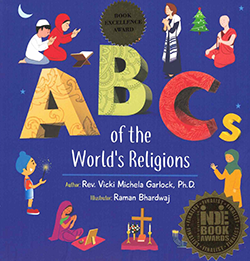ABC’s of the World’s Religions by Rev. Vicki Michela Garlock with illustrations by Raman Bhardwaj; Murrells Inlet, South Carolina: Eaton Press; (c) 2023; ISBN 9781947-486270, 52 pages plus introduction and appendices.

 SAN DIEGO — Rev. Vicki Michela Garlock, Ph.D., served as minister of education at the Jubilee Community Church in Asheville, North Carolina, and now as the founder of World Religions for Kids, devotes full-time to familiarizing people from age 4 through adulthood with the world’s faith traditions. Illustrator Raman Bhardwaj, a native of Chandigarh, India, is an artist currently based in Greensboro, North Carolina.
SAN DIEGO — Rev. Vicki Michela Garlock, Ph.D., served as minister of education at the Jubilee Community Church in Asheville, North Carolina, and now as the founder of World Religions for Kids, devotes full-time to familiarizing people from age 4 through adulthood with the world’s faith traditions. Illustrator Raman Bhardwaj, a native of Chandigarh, India, is an artist currently based in Greensboro, North Carolina.
With the author having grown up in western Christianity and the illustrator having experienced eastern religions, their collaboration, written in couplets on left-facing pages and with explanatory information on right-facing pages, uses the alphabet as a teaching vehicle. By and large, the book focuses on similarities among religions. The cover pictures believers in different religions in attitudes of prayer. A Jewish woman wears a tallit, an image that is applicable to non-Orthodox branches of Judaism but would not likely be seen in modern Orthodox or Hasidic congregations.
The alphabetic progression includes altars, Buddha, Christmas, Diwali, Exodus, fasting, gurus, hijab, India, Jayanti, Kaaba, Lent, Menorah, noble, om, prayer, Quran, relics, saints, temple, unity, Vesak, Waheguru, xenos, yarmulke, and zakat.
Even though the alphabetized word may come from a specific religion, comparable concepts in other religions are brought into the narrative. For example, “yarmulke” is explained as follows: “Most Jewish men, and many Jewish women, wear a cap when in synagogue. In this way, it is similar to the Sikh turban and the Islamic hijab. Also called a kippah, some Jews wear one whenever they are in public.”
For children, the couplets on the facing page read: “Y is for yarmulke (Yom-uh-Kuh)/ the small Jewish cap/ that comes in all colors./ Can you imagine that?
“Waheguru” is the name by which Sikhs call the Supreme Deity. They also call the deity “Satnam,” meaning true name. The text goes on to read, “Jews often use Hebrew titles like “HaShem” (the Name) or “Adonai” (Lord). Hindus might use “Brahman” (Ultimate Reality). And Muslims use “Allah,” the Arabic word for God.
The couplets for fasting read: “F is for fasting/ which means you don’t eat./ No fruits, no veggies, no dairy,/ and no meat.”
The explanation tells about Ramadan for Muslims; Yom Kippur for Jews, a 19-day fast in spring for the Baha’is, and Advent and Lent during which some Christians abstain from eating.
Rev. Garlock is always interested in learning more about the world’s religions, taking suggestions and possible amendments to heart. I offered a correction about the text for “Menorah,” which she graciously accepted for the book’s next edition.
*
Donald H. Harrison is publisher and editor of San Diego Jewish World.